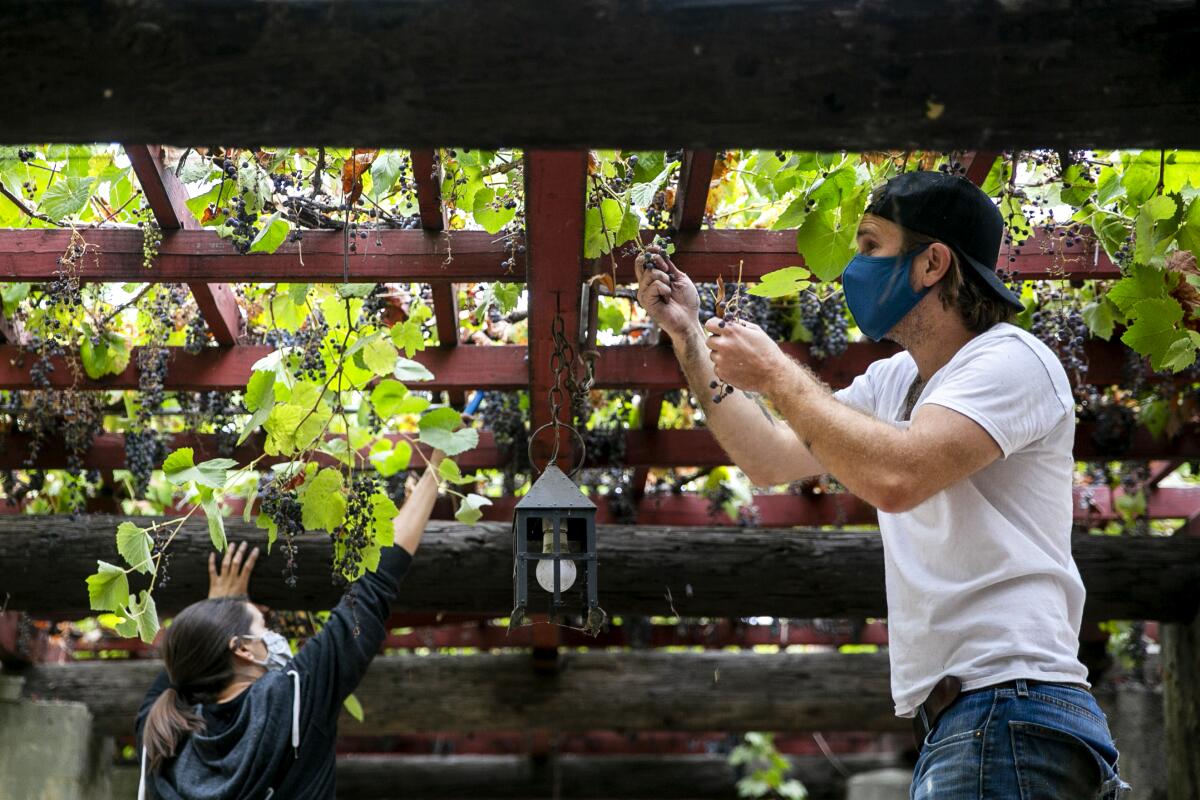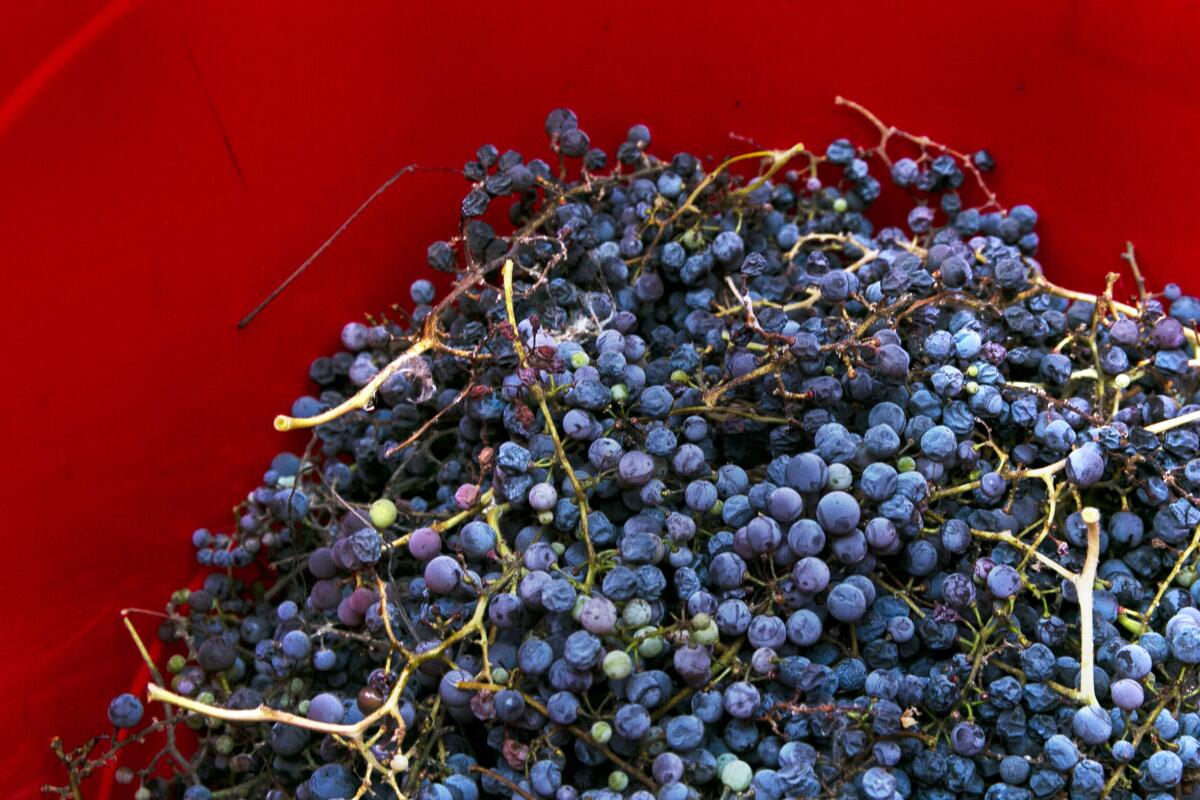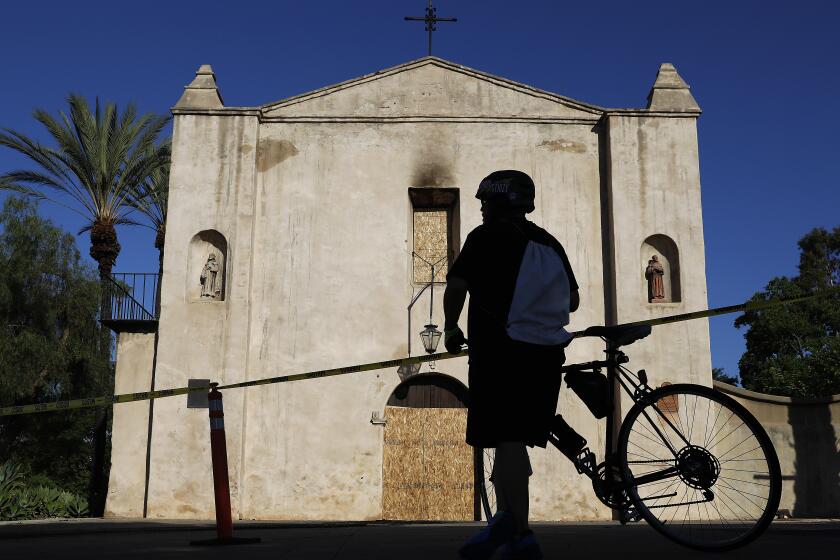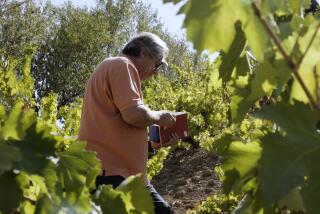Wine from the ‘Mother Vine’: A trio of L.A. winemakers are harvesting historic grapes at San Gabriel Mission

On a recent Saturday morning in the courtyard of the San Gabriel Mission, winemaker Jasper Dickson stood beneath a cluster of dark red grapes and gnarled vines.
Positioning his ladder against one of the church’s exterior walls, he glanced over at Terri Huerta, director of development and communications for the mission, and gestured to the 200-year-old adobe brick.
“OK if I lean this here?” he asked tentatively.
“Oh, that’s fine,” Huerta said with a smirk. “Those walls have been through worse.”
That might be putting it mildly. After surviving two powerful earthquakes in the 1980s, in July the historic mission-church was badly damaged by a massive fire that destroyed the roof and complicated a large-scale restoration that was underway in advance of the 250th anniversary of the mission’s founding next year.
Yet for anyone looking for a bit of news that isn’t connected to destruction, it might be found in the mission’s bucolic courtyard, home to a leafy green canopy of ancient grape vines that resembles kudzu run amok.
It’s here that Dickson, who runs Angeleno Wine Co. with partner Amy Luftig Viste, and a small group of local winemakers are at work on an unusual project: Harvest grapes from the mission’s historic vineyard and turn them into wine.
Along with Mark Blatty of Byron Blatty Wines and Patrick Kelley of Cavaletti Vineyards, Dickson and Luftig Viste are members of the Los Angeles Vintners Association, an organization founded last year that seeks to “revive the city’s viticultural and winemaking past.”
Earlier this year, Huerta reached out to members of the group to see if they would be interested in helping propagate the historic vines at San Gabriel Mission, the oldest of which — known as the Mother Vine or Trinity Vine — is said to date to the 1770s.
“These vines are living pieces of history, and for us it was an amazing opportunity just to be able to work with them,” Blatty said.
Once the group arrived to take cuttings, they noticed that the sprawling network of vines, which covers a large pergola covering most of the courtyard, was brimming with fruit — about 1,000 pounds of it, Blatty estimates.

“We sort of looked up and asked, ‘Hey, do you mind if we pick all this?’” Blatty said. “Nothing was being done with the grapes and we figured we might as well try and make something with them. It’s amazing to see vines that are this old but still produce a lot of fruit.”
A direct descendant of plantings made by Father Junipero Serra, the vines at San Gabriel Mission are something of an anomaly, viticulturally speaking.
A DNA test performed by UC Davis researchers in 2014 found that they were a cross between Vitis girdiana, a wild grape native to Southern California, and Vitis vinifera, otherwise known as the Mission grape, a prolific varietal that was carried from Spain and planted across the Americas.
For the Franciscan friars, the planting of vineyards at California missions was originally born out of a need for sacramental wine, a must-have for performing the rite of communion. It was at San Gabriel, however, that the Mission vines truly flourished; eventually the mission evolved into what might be considered California’s oldest winery.
For many, San Gabriel Mission church was where they went to Mass, married, celebrated. For others, it’s a reminder of brutal domination of Native Americans.
The success of the region’s earliest winemakers, however, came at the expense of Native peoples — cultivation and production at San Gabriel Mission was done through the forced labor of Tongva and other indigenous tribes, a reflection of the widespread brutality and racism that defined much of the mission era.
For some, Serra’s legacy is inextricable from his role in the decimation of California’s Native population, even as many Franciscan scholars have sought to reckon with the Catholic Church’s colonial past.
“We’ve always been open about the complexity of the mission’s past and discussing the full history,” Huerta said. “I think it’s important we tell these stories with more context and awareness, which includes how we present the grapevines and the role they played here.”
By the 1830s, a few years before the newly independent Mexican government officially secularized the missions, the vineyards at San Gabriel had expanded to more than 170 acres, producing as much as 50,000 gallons of wine per year.
Cuttings from the original San Gabriel vines were also planted widely across what was then known as El Pueblo de Los Ángeles (you can still spy them creeping through trellises on Olvera Street if you look closely) and would eventually provide the foundation for Southern California’s powerhouse wine industry, the nation’s largest for most of the 19th century.
The hegemony of the Mission grape, however, would not last forever. As more European immigrants arrived in California, prized French varieties such as Cabernet Franc and Sauvignon Blanc took root, crowding out the Mission, which became seen as an inferior grape that produced dull table wines with little acidity or flavor (though some winemakers have recently reconsidered that reputation).
A further blow to the region’s wine producers arrived in the 1880s with the spread of Pierce’s disease, an insect-transmitted bacteria that wiped out thousands of acres of vineyards and led many farmers to turn to more profitable orange and walnut production instead.
The handful of growers in Southern California who managed to survive Prohibition and the Great Depression found themselves selling their grapes for pennies on the dollar, cheaper than even the commodity grapes grown in areas like Bakersfield and Fresno.
“That was really the low point for the industry here,” Kelley said. “Wine grapes from Los Angeles weren’t seen as having value and they sort of vanished for a while.”
Next time you’re in downtown Los Angeles at Olvera Street and the historic El Pueblo complex, look up.
But despite decades of neglect, the original vines at San Gabriel Mission, fed by an underground aquifer, Kelley believes, quietly thrived. These days, the four most robust vines form a dense overgrowth that covers hundreds of square feet of the mission grounds. The massive roots of the largest — the Ramona Vine, planted in 1861 — are as thick as a tree trunk.
“It’s pretty rare to see productive vines that have grown to this size,” Kelley said. “This is probably one of the 10 largest in the world.”
After a long morning of ladder-climbing and pruning, the members of the Los Angeles Vintners Assn. estimated they had harvested enough fruit to produce one barrel of wine — 300 bottles, give or take. It’s a far cry from the booming days of San Gabriel winemaking, but it’s likely more than anyone has made in the last century.
Blatty said the plan is to use the grapes — small, marble-sized fruits with a sweet flavor and bitter tannins — to produce a wine known as Angelica, a semisweet fortified style that is somewhat similar to Port and was historically one of the more popular wines produced by the Franciscans at San Gabriel Mission.
“The name is actually taken from Los Angeles because it was a style that was typical of the city,” Blatty said. “It’s one of the original California wines, in a sense.”
Blatty has previously produced his own Angelica using Mission grapes grown in the Antelope Valley, but he’s curious to see flavors what the cross-bred San Gabriel grapes will yield (Dickson and Luftig Viste will handle production at their Angeleno Wine Co. near Chinatown).
If the timing works out, Blatty said, the barrel-aged Angelica will be ready for release during the mission’s 250th anniversary celebration, slated for September 2021.
But if you’re wondering when you can pick up a bottle at the shop, don’t hold you breath. Blatty expects demand for San Gabriel Mission wine will outstrip supply, at least until the newly planted vines at the mission start producing fruit in a few years.
“We see this current batch as a test run, and hopefully it’s something we can do annually,” Blatty said. “I mean, it’s wine that comes from some of the oldest vines in the country. Who wouldn’t want to try that?”
More to Read
Eat your way across L.A.
Get our weekly Tasting Notes newsletter for reviews, news and more.
You may occasionally receive promotional content from the Los Angeles Times.








